check engine Citroen C3 RHD 2015 2.G Owner's Guide
[x] Cancel search | Manufacturer: CITROEN, Model Year: 2015, Model line: C3 RHD, Model: Citroen C3 RHD 2015 2.GPages: 324, PDF Size: 9.86 MB
Page 157 of 324

155
Fuel tank
Low fuel level
When the fuel tank minimum level is
reached this warning lamp comes on
on the instrument panel. When it first
comes on there remains approximately
5 litres of fuel in the tank.
Filling
a label affixed to the inside of the flap reminds
y ou of the type of fuel to be used depending on
your engine.
Additions of fuel must be of at least 7 litres, in
order to be registered by the fuel gauge. To fill the tank safely:
F
t
he engine must be switched off,
F
o
pen the fuel filler flap,
F
i
nsert the key in the cap, then turn it to the
left,
F
r
emove the cap and hook it onto the clip
located on the inside of the flap,
F
f
ill the tank, but do not continue after
the 3rd cut- off of the pump
; this could
cause malfunctions.
When you have filled the tank:
F
p
ut the cap back in place,
F
t
urn the key to the right, then remove it
from the cap,
F
c
lose the flap.
You must refuel as soon as possible to avoid
running out of fuel.
If you run out of fuel (
di
esel), refer also to the
"Checks" section. Fuel tank capacity: approximately
50 litres (petrol) or 46 litres (Diesel) or
37 litres (LPG); (Depending on version:
approximately 30 litres (petrol or Diesel)).
With Stop & Start, never refuel with the
system in STOP mode; you must switch
off the ignition with the key. The key cannot be removed from the
lock until the cap is refitted.
op
ening the filler cap may create a
noise caused by an inrush of air. This
vacuum is entirely normal, resulting
from the sealing of the fuel system.
11
Practical information
Page 159 of 324

157
Mechanical device which prevents filling the
tank of a Diesel vehicle with petrol. It avoids
the risk of engine damage that can result from
filling with the wrong fuel.
Located in the filler neck, the misfuel
prevention device appears when the filler cap
is removed.
Misfuel prevention (diesel)*
Operation
When a petrol filler nozzle is introduced into the
fuel filler neck of your
di esel vehicle, it comes
into contact with the flap. The system remains
closed and prevents filling.
Do not persist but introduce a Diesel type
filler nozzle.
*
a
c
cording to country of sale. It remains possible to use a fuel can to
fill the tank.
In order to ensure a good flow of fuel,
do not place the nozzle of the fuel can
in direct contact with the flap of the
misfuel prevention device and pour
s l ow l y.
Travelling abroad
as
diesel fuel pump nozzles may
be different in other countries, the
presence of the misfuel prevention
device may make refuelling impossible.
Before travelling abroad, we
recommend that you check with the
CITROËN dealer network, whether your
vehicle is suitable for the fuel pumps in
the country in which you want to travel.
11
Practical information
Page 165 of 324
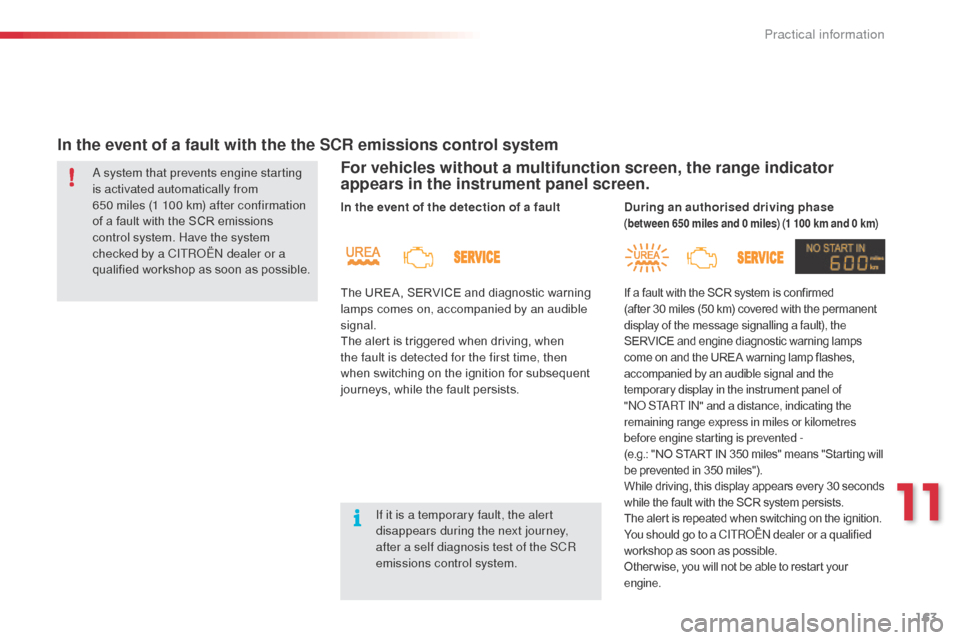
163
For vehicles without a multifunction screen, the range indicator
appears in the instrument panel screen.
In the event of a fault with the the SCR emissions control systema system that prevents engine starting
i s activated automatically from
650
miles (1 100 km) after confirmation
of a fault with the SCR emissions
control system. Have the system
checked by a CITR
oËn
dealer or a
qualified workshop as soon as possible. In the event of the detection of a fault
If it is a temporary fault, the alert
disappears during the next journey,
after a self diagnosis test of the SCR
emissions control system.
The UREA, SERVICE and diagnostic warning
lamps comes on, accompanied by an audible
signal.
The alert is triggered when driving, when
the fault is detected for the first time, then
when switching on the ignition for subsequent
journeys, while the fault persists.
If a fault with the SCR system is confirmed
(after 30 miles (50 km) covered with the permanent
display of the message signalling a fault), the
SERVICE and engine diagnostic warning lamps
come on and the UREA warning lamp flashes,
accompanied by an audible signal and the
temporary display in the instrument panel of
"
n
o ST
aR
T I
n" a
nd a distance, indicating the
remaining range express in miles or kilometres
before engine starting is prevented
-
(e.g.:
"NO START IN 350 miles" means "Starting will
be prevented in 350 miles").
While driving, this display appears every 30
se
conds
while the fault with the SCR system persists.
The alert is repeated when switching on the ignition.
You should go to a CITR
oËn
dealer or a qualified
workshop as soon as possible.
Other wise, you will not be able to restart your
engine.
During an authorised driving phase
(between 650 miles and 0 miles) (1 100 km and 0 km)
11
Practical information
Page 170 of 324
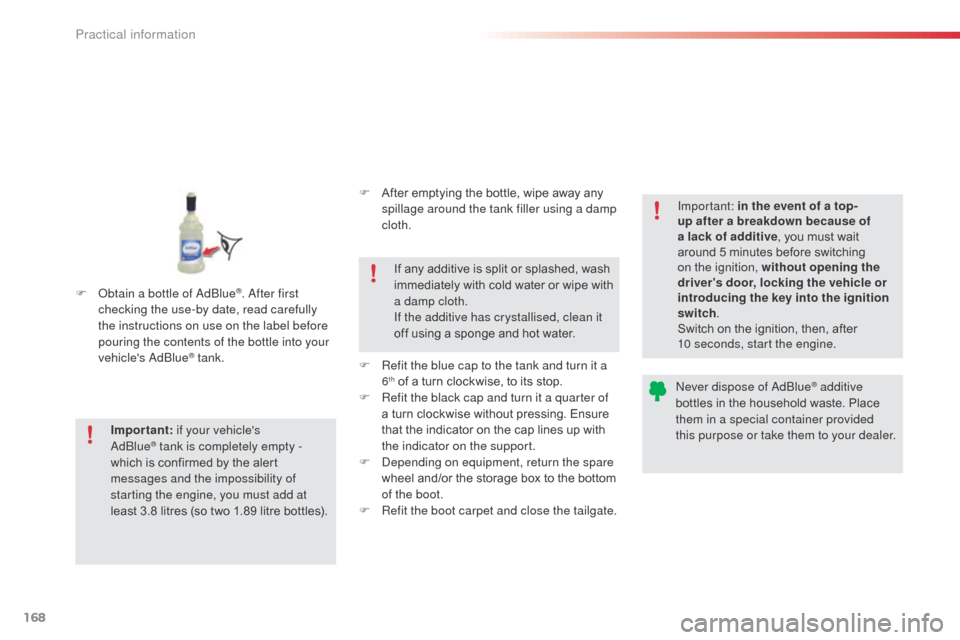
168
F obtain a bottle of adbl ue®. after first
checking the use-by date, read carefully
the instructions on use on the label before
pouring the contents of the bottle into your
vehicle's
a
d
blu
e
® tank.
Important : if your vehicle's
a
d
blu
e
® tank is completely empty -
w
hich is confirmed by the alert
messages and the impossibility of
starting the engine, you must add at
least 3.8 litres (so two 1.89 litre bottles). If any additive is split or splashed, wash
immediately with cold water or wipe with
a damp cloth.
If the additive has crystallised, clean it
off using a sponge and hot water.
Important: in the event of a top-
up after a breakdown because of
a lack of additive
, you must wait
around 5 minutes before switching
on the ignition, without opening the
driver's door, locking the vehicle or
introducing the key into the ignition
switch .
Switch on the ignition, then, after
10 seconds, start the engine.
ne
ver dispose of a
dbl
ue
® additive
bottles in the household waste. Place
them in a special container provided
this purpose or take them to your dealer.
F
A
fter emptying the bottle, wipe away any
spillage around the tank filler using a damp
cloth.
F
R
efit the blue cap to the tank and turn it a
6th of a turn clockwise, to its stop.
F
R
efit the black cap and turn it a quarter of
a turn clockwise without pressing. Ensure
that the indicator on the cap lines up with
the indicator on the support.
F
d
e
pending on equipment, return the spare
wheel and/or the storage box to the bottom
of the boot.
F
R
efit the boot carpet and close the tailgate.
Practical information
Page 199 of 324
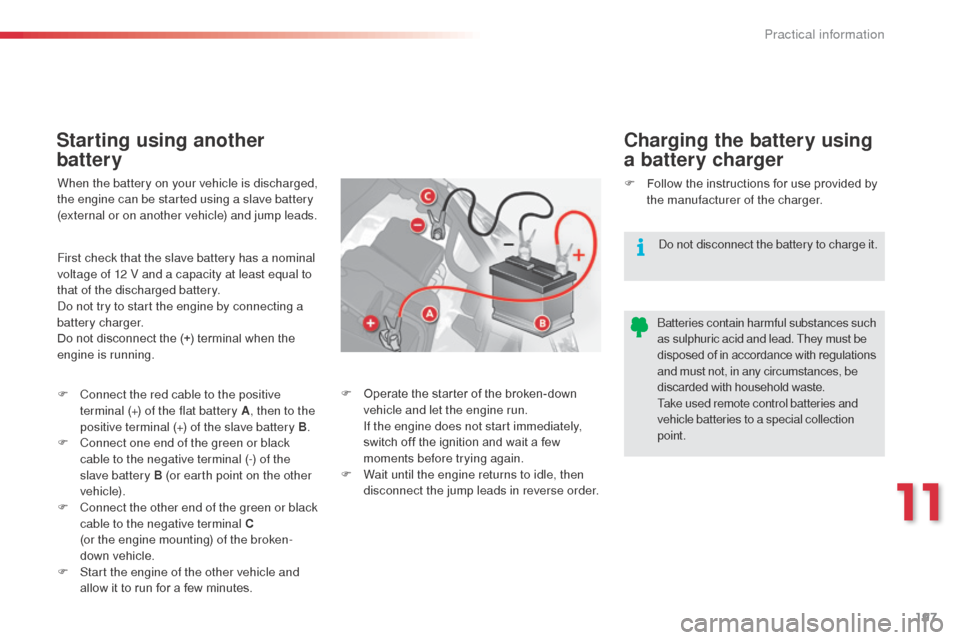
197
Starting using another
batteryCharging the battery using
a battery charger
When the battery on your vehicle is discharged,
the engine can be started using a slave battery
(external or on another vehicle) and jump leads. F
F ollow the instructions for use provided by
the manufacturer of the charger.
First check that the slave battery has a nominal
voltage of 12 V and a capacity at least equal to
that of the discharged battery.
do n
ot try to start the engine by connecting a
battery charger.
Do not disconnect the (+) terminal when the
engine is running.
F
C
onnect the red cable to the positive
terminal (+) of the flat battery A , then to the
positive terminal (+) of the slave battery B.
F
C
onnect one end of the green or black
cable to the negative terminal (-) of the
slave battery B (or earth point on the other
vehicle).
F
C
onnect the other end of the green or black
cable to the negative terminal C
(or the engine mounting) of the broken-
down vehicle.
F
S
tart the engine of the other vehicle and
allow it to run for a few minutes.
do n
ot disconnect the battery to charge it.
F
O
perate the starter of the broken-down
vehicle and let the engine run.
I
f the engine does not start immediately,
switch off the ignition and wait a few
moments before trying again.
F
W
ait until the engine returns to idle, then
disconnect the jump leads in reverse order.
ba
tteries contain harmful substances such
as sulphuric acid and lead. They must be
disposed of in accordance with regulations
and must not, in any circumstances, be
discarded with household waste.
Take used remote control batteries and
vehicle batteries to a special collection
point.
11
Practical information
Page 200 of 324
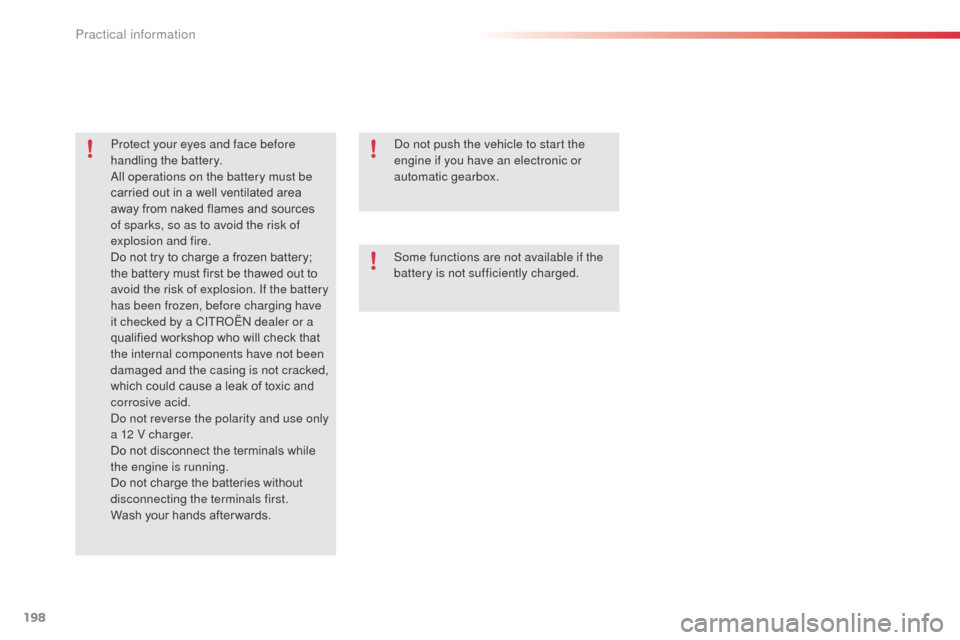
198
Protect your eyes and face before
handling the battery.
al
l operations on the battery must be
carried out in a well ventilated area
away from naked flames and sources
of sparks, so as to avoid the risk of
explosion and fire.
Do not try to charge a frozen battery;
the battery must first be thawed out to
avoid the risk of explosion. If the battery
has been frozen, before charging have
it checked by a CITR
oËn
dealer or a
qualified workshop who will check that
the internal components have not been
damaged and the casing is not cracked,
which could cause a leak of toxic and
corrosive acid.
do n
ot reverse the polarity and use only
a 12 V charger.
Do not disconnect the terminals while
the engine is running.
Do not charge the batteries without
disconnecting the terminals first.
Wash your hands after wards.do n ot push the vehicle to start the
engine if you have an electronic or
automatic gearbox.
Some functions are not available if the
battery is not sufficiently charged.
Practical information
Page 206 of 324

204
Braking
Towing a trailer increases the braking distance.
To avoid overheating of the brakes on a long
mountain type of descent, the use of engine
braking is recommended.
Ty r e s
F Check the tyre pressures of the towing vehicle and of the trailer, observing the
recommended pressures.
Lighting
F Check the electrical lighting and signalling on the trailer.
The rear parking sensors will be
deactivated automatically if a genuine
CITROËN towbar is used.
Cooling
Towing a trailer on a slope increases the
temperature of the coolant.
as t
he fan is electrically controlled, its cooling
capacity is not dependent on the engine speed.
F
T
o lower the engine speed, reduce your
speed.
The maximum towed load on a long incline
depends on the gradient and the ambient
temperature.
In all cases, keep a check on the coolant
temperature.
F
I
f the warning lamp and the
STOP warning lamp come on,
stop the vehicle and switch off
the engine as soon as possible.
Practical information
Page 281 of 324
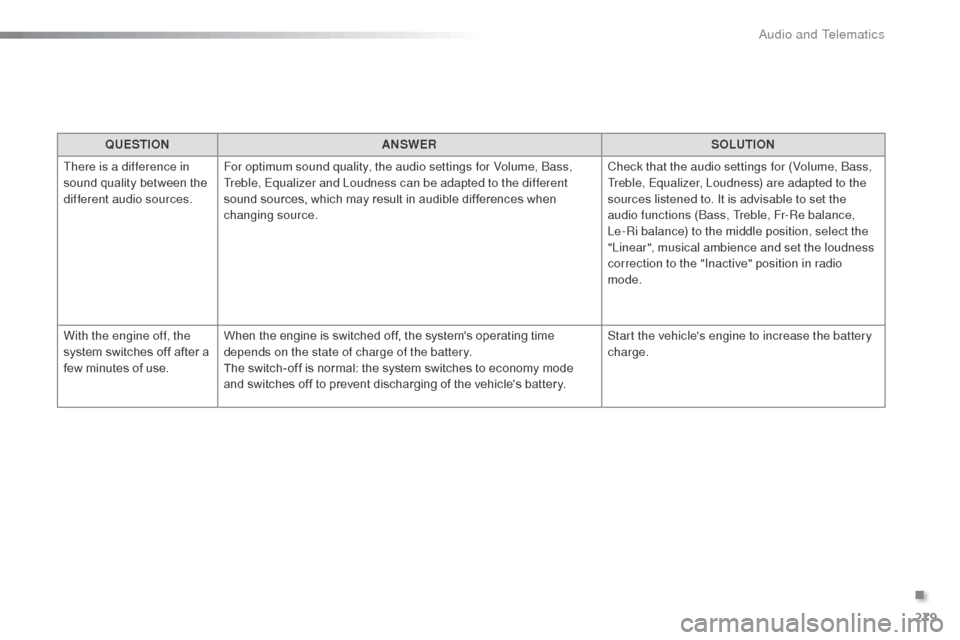
279
QUESTIONANSWER SOLUTION
There is a difference in
sound quality between the
different audio sources. For optimum sound quality, the audio settings for Volume,
b
a
ss,
Treble, Equalizer and Loudness can be adapted to the different
sound sources, which may result in audible differences when
changing source. Check that the audio settings for (Volume,
b
a
ss,
Treble, Equalizer, Loudness) are adapted to the
sources listened to. It is advisable to set the
audio functions (
ba
ss, Treble, Fr-Re balance,
Le-Ri balance) to the middle position, select the
"Linear", musical ambience and set the loudness
correction to the "Inactive" position in radio
mode.
With the engine off, the
system switches off after a
few minutes of use. When the engine is switched off, the system's operating time
depends on the state of charge of the battery.
The switch-off is normal: the system switches to economy mode
and switches off to prevent discharging of the vehicle's battery. Start the vehicle's engine to increase the battery
charge.
.
Audio and Telematics
Page 298 of 324
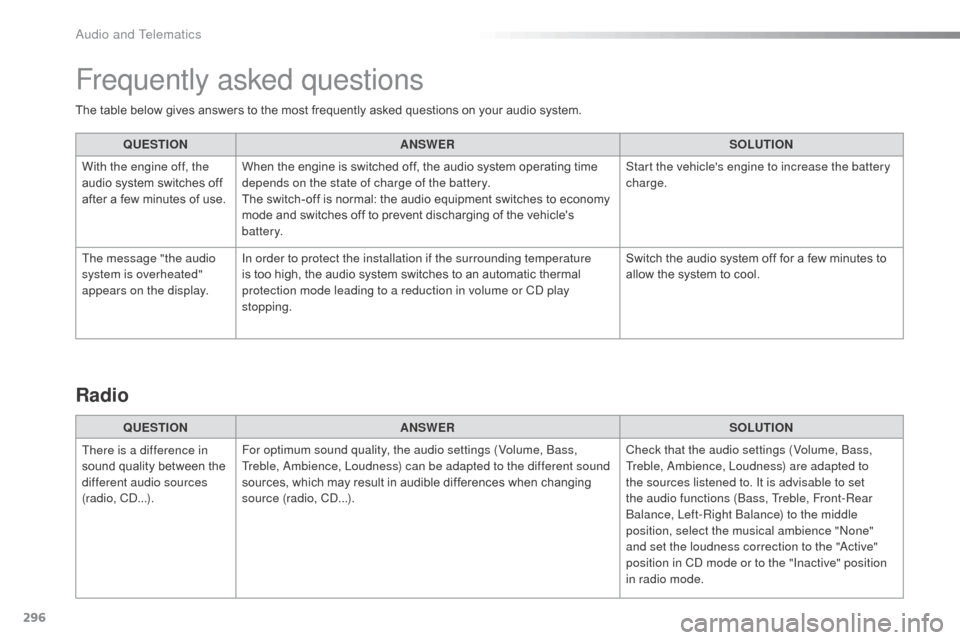
296
The table below gives answers to the most frequently asked questions on your audio system.QUESTION ANSWER SOLUTION
With the engine off, the
audio system switches off
after a few minutes of use. When the engine is switched off, the audio system operating time
depends on the state of charge of the battery.
The switch-off is normal: the audio equipment switches to economy
mode and switches off to prevent discharging of the vehicle's
battery. Start the vehicle's engine to increase the battery
charge.
The message "the audio
system is overheated"
appears on the display. In order to protect the installation if the surrounding temperature
is too high, the audio system switches to an automatic thermal
protection mode leading to a reduction in volume or C
d
play
stopping. Switch the audio system off for a few minutes to
allow the system to cool.
Frequently asked questions
QUESTION
ANSWER SOLUTION
There is a difference in
sound quality between the
different audio sources
(radio, C
d...
). For optimum sound quality, the audio settings (Volume,
b
a
ss,
Treble,
a
m
bience, Loudness) can be adapted to the different sound
sources, which may result in audible differences when changing
source (radio, C
d...
). Check that the audio settings (Volume,
b
a
ss,
Treble,
a
m
bience, Loudness) are adapted to
the sources listened to. It is advisable to set
the audio functions (
ba
ss, Treble, Front-Rear
balanc
e, Left-Right b
alanc
e) to the middle
position, select the musical ambience "
no
ne"
and set the loudness correction to the "
ac
tive"
position in C
d
mode or to the "Inactive" position
in radio mode.
Radio
Audio and Telematics
Page 305 of 324
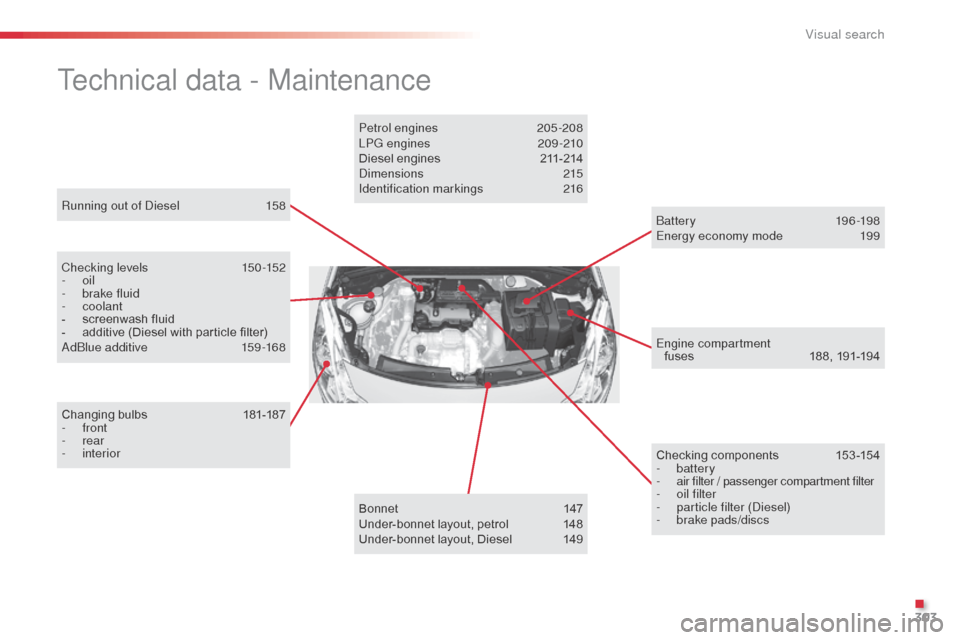
303
Running out of diesel 1 58
Technical data - Maintenance
Checking levels 150 -152
- oil
-
b
rake fluid
-
coolant
-
s
creenwash fluid
-
a
dditive (Diesel with particle filter)
a
d
blu
e additive
1
59-168
Changing bulbs
1
81-187
-
front
-
rear
-
interior Checking components
1
53 -154
-
battery
-
a
ir filter / passenger compartment filter
-
o
il filter
-
p
article filter (
di
esel)
-
b
rake pads/discs
Engine compartment
fuses
1
88, 191-194
ba
t ter y
19
6 -198
Energy economy mode
1
99
Bonnet
1
47
Under-bonnet layout, petrol
1
48
Under-bonnet layout, Diesel
1
49
Petrol engines
2
05 -208
LPG engines
2
09-210
Diesel engines
2
11-214
di
mensions
2
15
Identification markings
2
16
.
Visual search